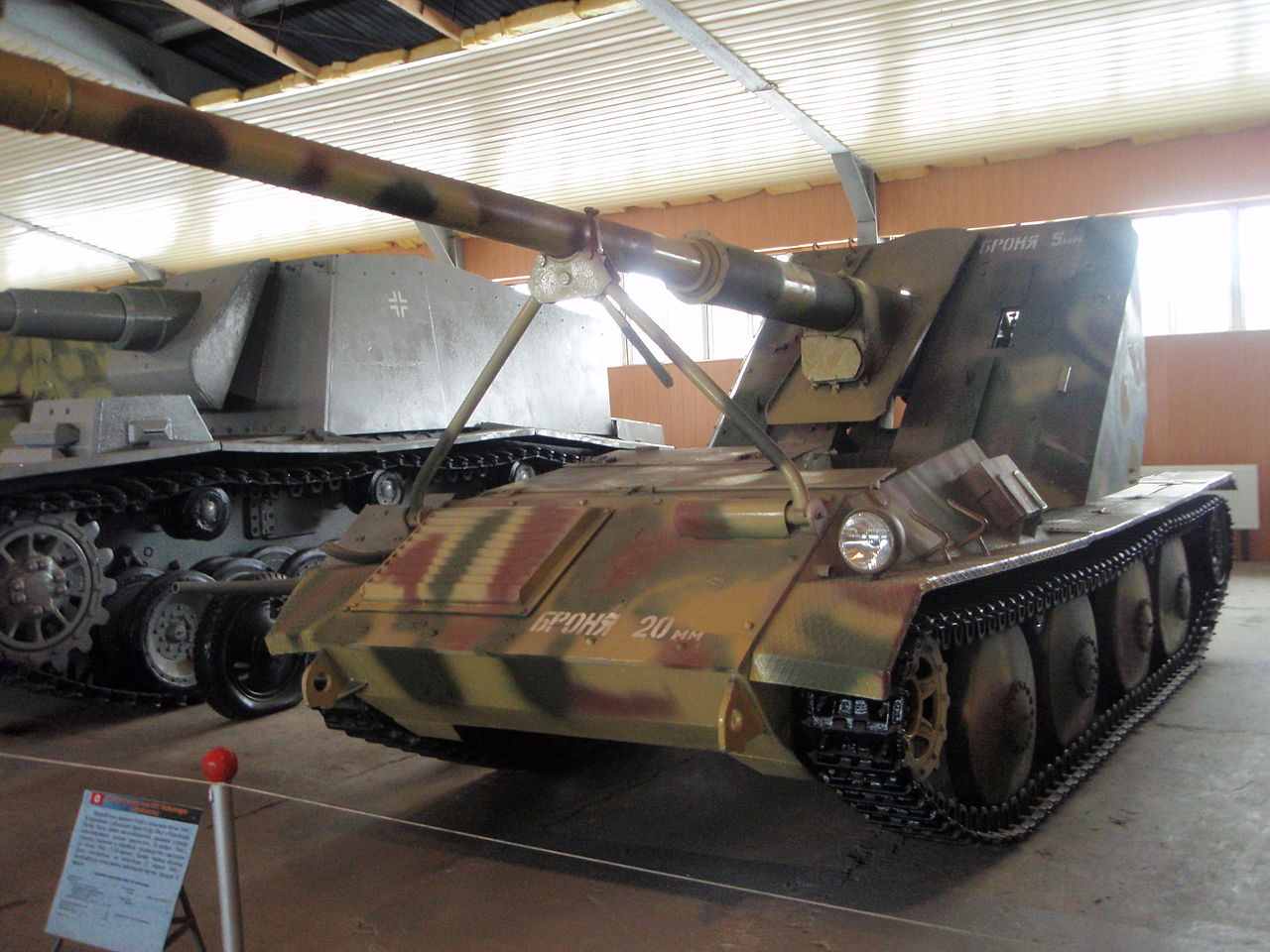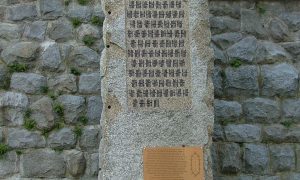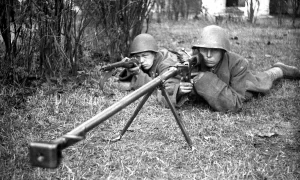Official designation:
Alternative designation: Waffentrager 8.8cm PaK 43 L/71 (Ardelt)
Work started: 1942 First prototype built: 1944
Stage of completion: two prototypes built and a small series of 10-20 vehicles.
Waffentrager Characters
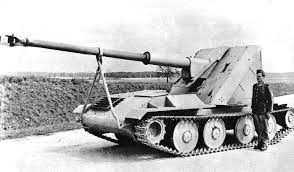
The terms of reference for the development of a fundamentally new combat vehicle, which in the German classification was called the Waffentrager (weapon carrier), was formulated by the artillery and technical supply department at the end of 1942. It was assumed that two main types of carriers would be developed in parallel. The first one could be considered light and was supposed to mount a 75 mm PaK 40L/70 anti-tank gun, a 105 mm FH 18/40 howitzer, or a 37 mm FlaK anti-aircraft gun. The second type of carrier was intended for the more powerful 88 mm PaK 43 L/71 gun, the 150 mm FH 43 howitzer, and the 128 mm K43 gun. One of the main requirements was the possibility of circular fire. In addition, it was assumed that the gun would be removed from the undercarriage and mounted on a conventional field carriage.
Due to the insufficiently high priority and the workload of other orders from large firms, work progressed very slowly. Only at the end of 1943, Krupp, Daimler-Benz and Steyr-Daimler-Puch submitted their projects to the artillery supply department, but did not receive full approval due to the high complexity of the design. The main problem was that the “gunners” themselves did not really know what they wanted. After much deliberation, at the end of February 1944, the final version was approved with the installation of an 88-mm anti-tank gun on the chassis of the Jagdpanzer 38 (t) Hetzer serial self-propelled gun, but at the same time, driving performance was not lower than that of the RSO tracked tractor. Oddly enough, but in this sharp struggle, the project of the almost unknown Dr. Günter Ardelt became the winner.
The idea to create self-propelled guns came to him after his stay on the Eastern Front, where Adelt witnessed the capture by Soviet troops of 70 new PaK 43 anti-tank guns. volume. This system was tested at the Kummersdorf test site, but military experts recognized it as unsuccessful. Then Ardelt, initially not taking part in the competition, decided to try his hand at a more difficult task – they were asked to create a unified chassis for all types of guns, and already at the beginning of 1944, WaPruf 4 issued the corresponding technical task, but with the condition that the carrier would have to equally well suited for mounting the 105 mm leFH 18/40 howitzer,
The first prototype, presented to the customer a few months later, had several design flaws and did not pass the tests. Nevertheless, the specialists from WaPruf 4, who had already decided on the choice of the main artillery system, issued a new order for the manufacture of an improved version of the self-propelled gun.
The undercarriage used 8 road wheels with spring-balance suspension and caterpillar tracks from the Hetzer self-propelled unit. The drive wheels were located in front, the guides were in the back. The body of the Ardelt self-propelled gun had a welded structure and was assembled from sheets of rolled armor steel sheets with a thickness of 8 to 20 mm. The power plant was located in front of the hull. Here, with an offset to the starboard side, a 4-stroke 6-cylinder Maybach HL 42 gasoline engine was installed. The liquid in the cooling system circulated using a centrifugal pump. The lubrication system included an oil tank, an oil filter, a pump and an oil-water cooler. The power system used a fuel priming pump, Solex carburetor, intake manifold and air cleaner. Two fuel tanks were located on the sides of the pedestal installation of the gun. The ignition was made from a magneto with automatic advance control. The transmission was also located in front of the hull and consisted of an intermediate gearbox, main clutch,
The electrical equipment was made according to a single-wire circuit and consisted of a generator with a relay-regulator. one battery (installed in a special box behind the back of the driver’s seat), electric starter, road headlight. charging control lamp and box for six fuses. The means of communication included only an intercom for the driver and commander of the vehicle. The radio station was not installed due to lack of space in the case.
The 8.8cm PaK 43 L / 71 gun was mounted on a pedestal mount, which was attached to a U-shaped beam mounted across the hull. The design of the pedestal made it possible to fire in a circular sector, however, firing on the move was not allowed. To protect against bullets from light small arms, an armored shield with a sheet thickness of 5 mm was installed. To increase bullet resistance, the frontal sheet was installed at a large angle of inclination. In the stowed position, the barrel of the gun was fixed using a special scissor-like support fixed to the front hull plate. The ammunition load consisted of 32 shots: 6 shells were in a box on the inside of the shield and another 12 shells were placed in boxes in the rear of the hull.
The crew of self-propelled gun Ardelta consisted of four people. The driver’s seat and controls were located in front of the case on the left side. For observation, a hatch was used in the roof of the hull, and in a combat position, the review could only be carried out through a viewing slot in the armored shield. The gunner was located to the left of the gun, while the commander and loader were placed on the seats at the rear of the vehicle. In order to simplify the design, heating and lighting of crew jobs were absent.
Tests of the second prototype, which took place in the summer of 1944 at the ground forces training ground in Hillersleben, confirmed the correctness of the chosen path and already in August the self-propelled gun was presented to A. Hitler along with other competitors. Despite the fact that the Arlelt design did not provide for a transition to a field carriage, it was she who was chosen for mass production. The self-propelled gun turned out to be much more technologically advanced, had the smallest possible dimensions and acceptable driving performance.
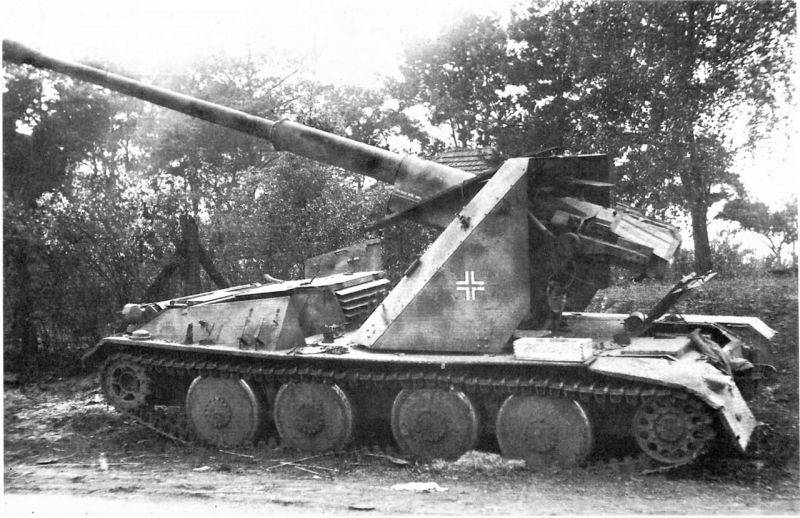
Such an unexpected outcome of the competition did not come as a complete surprise to Ardelt. Rather, on the contrary, the company was ready to produce self-propelled guns, but the corresponding decision was made by WaPruf 4 only on November 13, 1944. To organize production, a working group was created under the leadership of Oberengineer Kracht from Auto-Union, after which Ardelt was offered to modify his sample in relation to the conditions of mass production. Production plans deployed from the spring of 1945 were impressive: March – 5 cars, April – 15, May – 30. June – 50, July – 80, August – 120, September – 170, October – 250, November – 300 and, starting from December, 350 per month. Exact information about how many Waffentrager Ardelt designs were built was not preserved. It is currently known that one of the serial samples was tested at the Hillersleben training ground on April 27, 1945, and two more self-propelled guns were captured in May by units of the 3rd Army of General A. Gorbatov (1st Belorussian Front) during the storming of Berlin: one of them the Germans left in the area Wandisch-Buchholz, and another in Brandenburg. Thus, there is every reason to believe that a small series of 10 cars was produced. The fate of Ardelt himself turned out to be tragic. According to the German researcher W. Shpilberger, the designer “died on one of his Waftentragers. defending his hometown of Eberswilde.”
Further, the fates of captured self-propelled guns were divided. In 1945, one of the captured Waffentragers, with the inscription “From Berlin” on board, was exhibited at the exhibition of captured weapons and equipment at the Gorky Central Park of Culture and Culture in Moscow. In the spring of 1946, this car was sent to the Kubinka training ground, where it was subjected to comprehensive tests. In Soviet documents, the Waffentrager designed by Dr. Ardelt was referred to as “an open German self-propelled gun with an 88 mm PaK-43 cannon”, which was generally quite accurate.
The technical condition of the self-propelled gun by that time was unsatisfactory, which was the result not so much of operational deterioration as of general design flaws in the chassis (which was immediately noted by Soviet specialists). In total, they managed to cover only 200 km and fire 56 shots, which can be considered quite good indicators. Considering that the Germans had practically no time to deploy mass production, the German self-propelled gun turned out to be quite successful. However, a number of shortcomings prevented the full combat use of this machine. During the run, insufficient engine cooling, lack of basic amenities for the crew and low mobility characteristics were noted. The following was recorded in the test report:
“The German self-propelled artillery mount with a RAK-43 cannon belongs to the class of open self-propelled mounts with circular fire. In terms of weight (11.2 tons), it can be attributed to light self-propelled guns – ZSU-37 and SU-76; in terms of shot power (52500 kgm) to heavy self-propelled units such as ISU-152 and Ferdinand and is inferior in this respect to SU-100 and ISU-122 units.
When it was created, the following were used: – 88-mm PaK-43 anti-tank gun, previously installed on the Hornisse self-propelled guns: – HL-42 engine, main clutch, gearbox, turning mechanism and final drives from German light half-track tractors; – caterpillars from the tank “Prague” 38-T. The specified unification of most of the main units indicates the desire to reduce the cost and mass production of a new model of self-propelled guns.
However, a number of weak points of the installation – the engine cooling system, the gear shift mechanism, the lack of crew protection from dust, dirt and precipitation, the fastening of the road wheel covers – indicate the short time frame for designing, developing and manufacturing the first batch of machines.
The fundamental idea of the design of the installation – the open placement of an artillery system with a circular fire – fully justified itself. This event managed to ensure good working conditions for the calculation, essentially no different from the working conditions for the calculations of field artillery systems.
At the same time, it was noted that, having the opportunity to fire only from a place, the ballistic characteristics of the 88-mm guns were at their best. In particular, at a distance of 1000 meters, the probable deviations in height and direction did not exceed 0.22 mm, and the armor-piercing projectile confidently pierced the armor of the main Soviet T-34-85 tank from all projections and the IS-2 heavy tank from the side and aft projections. The rate of fire was 7.4 rounds per minute. The work of the gun crew was also facilitated by the fact that, due to the low line of fire, the gun could be loaded even while standing on the ground. In addition to this, the two crew members did not have clearly fixed places: when firing, the commander was outside the vehicle, and the loader could be to the left or right of the gun. An interesting feature was the use of a captured Japanese sight (apparently The “native” sight was broken back in Germany). In general, the advantages of the Waffentrager were as follows:

Positive Characters
1. A powerful artillery system that provides an armor-piercing projectile with a manpower of 52500 kgm at an initial speed of 1000 m/s.
2. Open placement of the gun, providing good working conditions for the calculation.
3. Satisfactory stability of the installation, achieved by using a muzzle brake, a large recoil length and a good placement of the center of gravity.
4. High maneuverability of fire, provided with a circular fire and a unitary shot.
5. Fast transfer of fire in any sector of fire, achieved by turning the gun with the rotary mechanism turned off.
6. Quick transition from traveling to combat position.
7. Successful gun stopper in a stowed way, securely and simply fixing the gun.
8. Compact placement of the units of the engine compartment, achieved by the introduction of an intermediate gearbox between the engine and the main clutch”

Shortcomings
However, the shortcomings of the self-propelled gun turned out to be even more. Perhaps, if Dr. Ardelt had more time and resources, his Waffentrager could become one of the best light self-propelled guns of the final period of the war. But still:
1. Specific power – 9 hp / t. — insufficient.
2. The lack of protection of the driver from the blast wave during shelling and the lack of fences for the calculation exclude shooting from the move and short stops.
3. Correction of fire by the gunner through the sight and through the hatch of the armored shield is impossible due to the covering of the target and the tracer by powder gases.>
4. The absence of an easily removable awning over the firing platform and a protective cap over the control compartment. As a result, the crew is completely unprotected from dust, dirt and precipitation.
5. A defect in the engine cooling system, which consists in the following: there is no tensioner for the drive belt to the fan, the formation of oncoming air flows heated by the engine and ejected by the fan through the shutters in the front sheet and external (especially in a headwind) entering the engine compartment through the shutters.
6. Insufficient reliability of the gear shift mechanism.
7. Unreliable fastening of the suspension roller covers.
8. Significant removal of the driver’s seat pedals.
9. Unsuccessful design of the seats of the firing platform.
10. Departure in front of the tracks of the towing loops, as a result of which the height of the overcome vertical obstacles is limited.
11. Insufficient transportable supply of shells. As a result, it was concluded that, in general, the design deserves attention, but cannot be used as a role model. For Soviet “open type” self-propelled guns, it was recommended to use the base of serial T-44 or T-54 tanks, as well as a high-speed 100-mm anti-tank gun (presumably they meant systems based on the D-10 or BS-3).


